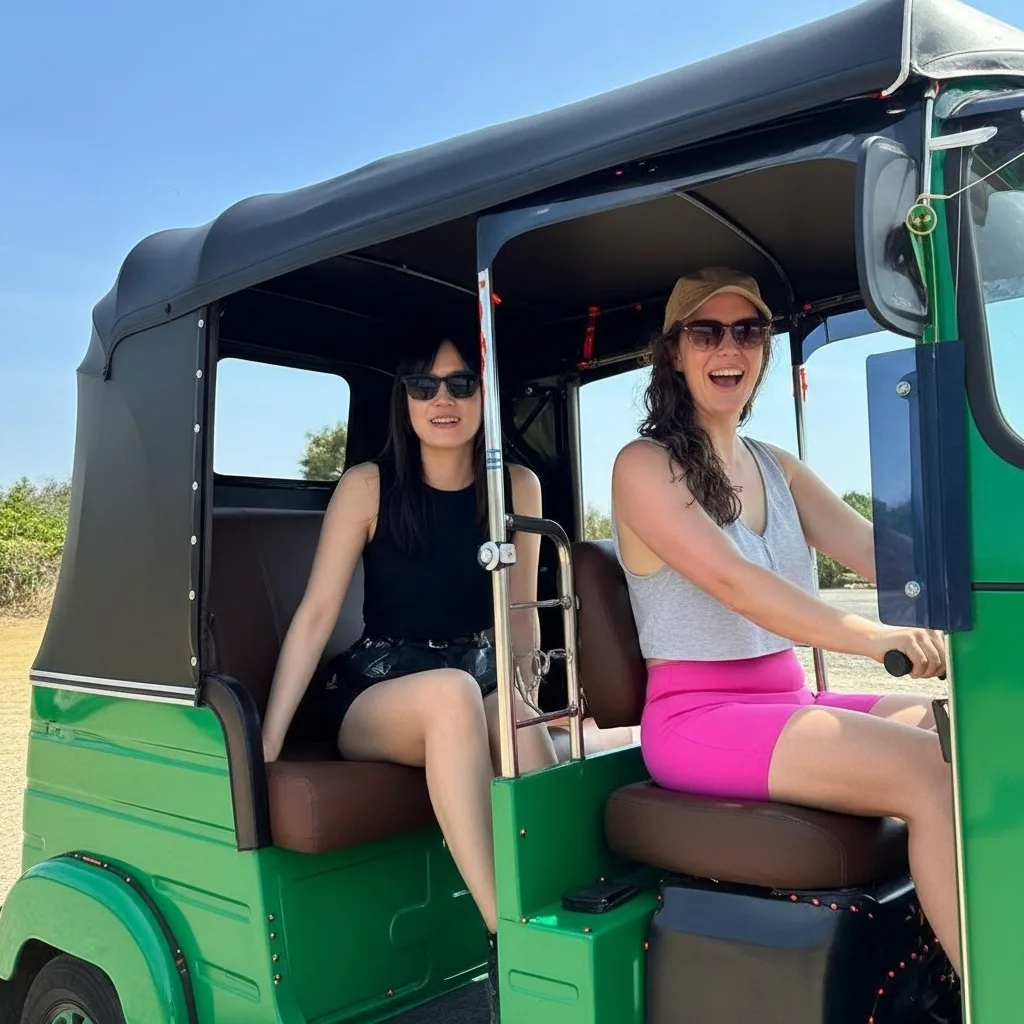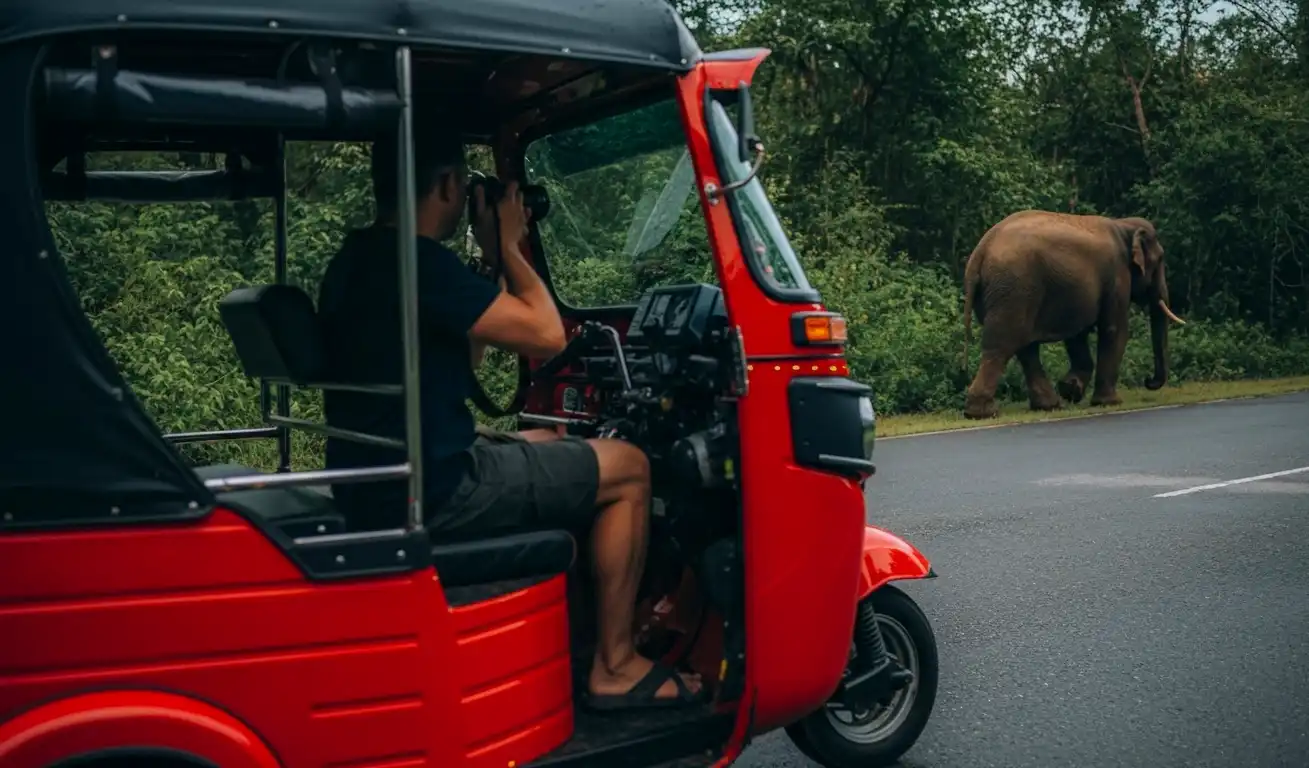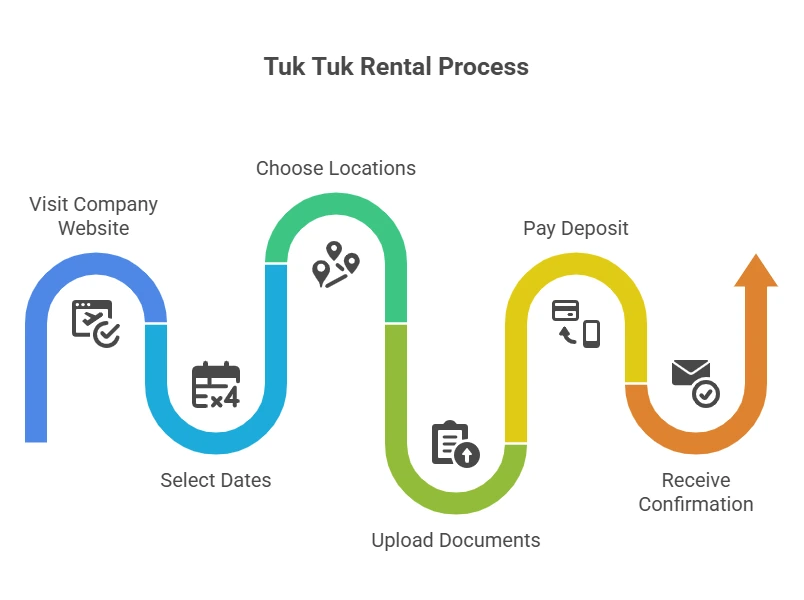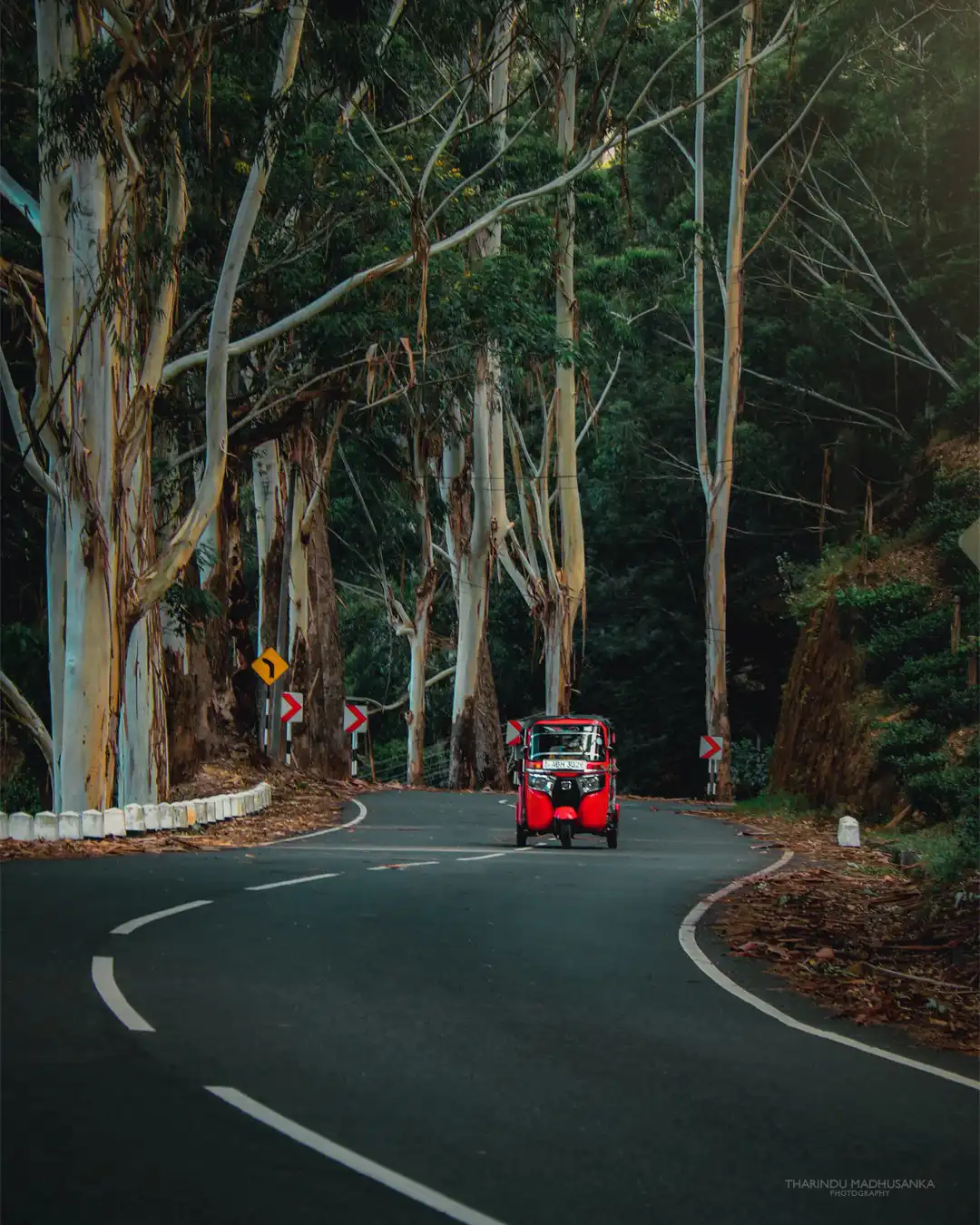How to Rent a Tuk Tuk in Sri Lanka: Your Complete Guide to the Ultimate Island Adventure
 https://res.cloudinary.com/daknktzcc/image/upload/v1761469423/rent_a_tuktuk_in_sri_lanka_od8ndq.webp?height=600&width=800
https://res.cloudinary.com/daknktzcc/image/upload/v1761469423/rent_a_tuktuk_in_sri_lanka_od8ndq.webp?height=600&width=800How to Rent a Tuk Tuk in Sri Lanka: Your Complete Guide to the Ultimate Island Adventure
The Three-Wheeler That'll Change Your Entire Sri Lankan Adventure
Picture this: You're weaving through palm-fringed coastal roads, the Indian Ocean glittering to your left, while a symphony of horns (mostly friendly, I promise) creates the soundtrack to your Sri Lankan odyssey. Your chariot? A bright yellow tuk tuk that's about to become your best friend, your freedom machine, and quite possibly the reason you'll have the most memorable stories to tell when you get home.
I'll be straight with you. Renting a tuk tuk in Sri Lanka isn't just about getting from point A to point B. It's about claiming your independence on one of Asia's most enchanting islands, where every turn reveals a new temple, a roadside tea stall, or a view that'll make you pull over just to breathe it all in.
But here's the thing: before you jump into that three-wheeled adventure, there are things you need to know. Permits, costs, insurance, the whole shebang. Lucky for you, I've put together everything you need to transform from curious traveler to confident tuk tuk pilot.
What You Actually Need to Get Behind the Wheel
Let's cut through the confusion right away because this is where most travelers get tripped up.
The Document Checklist
To rent and drive a tuk tuk in Sri Lanka, you'll need a surprisingly short list of essentials. First up is your passport (obviously), but the real star of the show is something called an International Driving Permit, or IDP for short. Think of it as your regular driving license's passport.
Here's what you need to have ready:
- Your valid home country driving license (must be current, not expired)
- An International Driving Permit (IDP) issued in your home country
- Your passport with a valid Sri Lankan visa
- A credit card for the security deposit (most companies require this)
Now, some travelers ask me, "Can't I just use my regular license?" Technically, no. Sri Lankan law requires foreign drivers to have either an IDP or convert their license into a temporary Sri Lankan driving permit. But here's where it gets interesting.
The Sri Lankan Driving Permit Mystery Solved
Do you need a Sri Lankan driving permit? The answer is: it depends on how official you want to get.
Most tuk tuk rental companies will accept your IDP without requiring you to get a local permit. However, if you want to be absolutely bulletproof when it comes to the law, you can obtain a temporary Sri Lankan driving permit. You'll get this from the Department of Motor Traffic in Colombo or regional offices.
The process isn't terrible. You'll need to bring your IDP, passport, passport-sized photos, and about 3,500 Sri Lankan Rupees (roughly $10-12 USD). The catch? You might spend a few hours navigating bureaucracy. My advice? If you've got an IDP and your rental company accepts it, you're golden for most situations. Save the local permit hassle unless you're planning an extended stay or want extra peace of mind.

The Money Talk: What It Really Costs to Rent a Tuk Tuk
Let's talk numbers because this is probably one of your burning questions.
Tuk tuk rental costs in Sri Lanka vary based on the company, season, and how long you're renting. But I can give you the realistic breakdown.
Daily Rental Rates
| Rental Duration | Average Cost (USD) | Average Cost (LKR) |
|---|---|---|
| 1-2 days | $25-35 per day | 7,500-10,500 per day |
| 3-7 days | $20-30 per day | 6,000-9,000 per day |
| 1-2 weeks | $18-25 per day | 5,400-7,500 per day |
| 3+ weeks | $15-22 per day | 4,500-6,600 per day |
Here's the beautiful part: the longer you rent, the better your daily rate becomes. If you're committing to a proper Sri Lanka travel by tuk tuk adventure (say, two weeks exploring the Pekoe Trail or the entire southern coast), you're looking at spending around $300-350 total. That's less than what you'd pay for a few days of private car hire with a driver.
What's Included (And What's Not)
Most tuk tuk rental companies include basic insurance in that daily rate. You'll typically get third-party liability coverage, which protects you if you accidentally bump into someone else. But comprehensive insurance (covering damage to your tuk tuk) often costs extra, usually around $3-5 per day.
Fuel? That's on you. But here's some good news: tuk tuks are incredibly fuel-efficient. You'll spend roughly $15-20 per day on petrol if you're doing moderate distances. They sip fuel rather than guzzle it.
Security deposits range from $200-500, depending on the company and the condition of the tuk tuk. This gets refunded when you return the vehicle undamaged.
Age Restrictions and Experience Requirements
The minimum age to rent or drive a tuk tuk in Sri Lanka is typically 21 years old, though some companies will rent to 18-year-olds with additional insurance requirements. You'll also need to have held your driving license for at least one year.
Do you need prior experience to drive a tuk tuk? Technically no, but practically speaking, yes, you should have some confidence behind the wheel. If you can drive a manual car or even a scooter, you'll adapt quickly. Most rental companies offer a brief tutorial (15-30 minutes) where they'll show you the basics: gear shifting (yes, tuk tuks have gears), turning radius, and the all-important horn etiquette.
I won't sugarcoat it: tuk tuks handle differently than cars. They're lighter, tippier, and have a completely different center of gravity. Spend your first hour on quieter roads getting the feel for it. Your confidence will build fast.

Booking Your Tuk Tuk: Online vs On-the-Ground
How do you book a tuk tuk online in advance? It's easier than you might think.
Top Tuk Tuk Rental Companies
Several reputable companies specialize in tuk tuk rentals across Sri Lanka. Here are the standouts:
TukTukRental.com is probably the most well-known player in the game. They've got a massive fleet, multiple pickup locations (Colombo, Kandy, Galle, Negombo), and their website makes booking straightforward. You can reserve your tuk tuk months in advance, choose your pickup/drop-off locations, and even request specific paint jobs if you're feeling particular.
Tuk Tuk Rental Sri Lanka (based mainly in Colombo and the western province) offers competitive rates and excellent customer service. They're particularly good if you're landing at Bandaranaike International Airport and want to start your adventure immediately.
PickMe (yes, the app) has recently expanded into self-drive tuk tuk rentals. If you're already using PickMe for regular tuk tuk rides, you can explore their rental options through the app.
The Booking Process
Most companies require you to book at least 48 hours in advance during high season (December to March), though you can sometimes score same-day rentals during quieter months. Here's what the typical process looks like:
- Visit the company's website and select your dates
- Choose your pickup and drop-off locations (one-way rentals are often possible)
- Upload photos of your IDP and passport
- Pay a deposit (usually 20-30% of the total rental)
- Receive confirmation with pickup instructions
The entire booking process takes about 15 minutes if you've got your documents ready.

Pro tip: Some companies offer perks like free delivery to your hotel or airport pickup for multi-week rentals. Always ask about these extras.
Safety First: Is Driving a Tuk Tuk in Sri Lanka Actually Safe?
Let me address the elephant in the room: is it safe to drive a tuk tuk in Sri Lanka?
The honest answer is yes, but with important caveats.
Sri Lankan traffic operates on what I call "organized chaos" principles. There are rules, people mostly follow them, but there's also a lot of creative interpretation happening. Horns aren't aggressive; they're communicative. A quick beep means "I'm here," a longer honk means "I'm passing you," and a really long blast means "please move."
Real Safety Tips for Tuk Tuk Driving
Start slow and build confidence. Your first day should be about shorter distances and quieter roads. The worst thing you can do is pick up your tuk tuk at Colombo Airport and immediately try to navigate Colombo's rush hour. That's a baptism by fire nobody needs.
Watch for buses. Private buses in Sri Lanka are legendary for their aggressive driving. Give them space and let them pass. Trust me on this.
Animals have right of way. Cows, dogs, monkeys, and the occasional peacock will wander into roads. Slow down in villages and keep your eyes peeled.
Night driving is a different beast. Many rural roads lack proper lighting, and not all vehicles use headlights properly. If you can avoid driving after dark, do so.
The roads themselves vary wildly. Main roads are generally good, but once you head into rural areas or the hill country, you'll encounter potholes, sudden steep inclines, and roads that narrow without warning.
That said, thousands of travelers successfully navigate Sri Lanka by tuk tuk every year. You just need to be alert, patient, and willing to embrace a different driving culture.
Insurance and Breakdown Coverage: What Happens When Things Go Wrong
What kind of insurance is included with a tuk tuk rental? As I mentioned earlier, most companies include basic third-party liability. This covers damage or injury to others if you're at fault in an accident.
But here's what you need to consider adding:
Comprehensive damage waiver reduces or eliminates your financial responsibility if the tuk tuk gets damaged. Without it, you could be on the hook for repair costs that come out of your security deposit.
Personal accident insurance covers medical expenses if you're injured while driving. Your travel insurance might already cover this, so check before paying twice.
Theft protection is rarely needed but available if you're particularly worried.
What Happens If Your Tuk Tuk Breaks Down?
Mechanical failures happen. Tuk tuks are simple machines, but they work hard. What happens if your tuk tuk breaks down?
Every reputable rental company provides a breakdown hotline (usually available 24/7). When you rent, you'll get an emergency contact number. Call it, explain your situation and location, and they'll either:
- Talk you through a simple fix (tuk tuks are refreshingly mechanical)
- Send a local mechanic to your location
- Arrange a replacement tuk tuk if the repair will take significant time
Most minor issues (overheating, fuel problems, flat tires) can be sorted within an hour. Major breakdowns are rare but might leave you waiting a bit longer in remote areas.
Keep the rental company's contact card in your wallet and save the number in your phone. You'll probably never need it, but you'll be grateful to have it if you do.
Traveling Together: Can You Fit Your Crew in One Tuk Tuk?
Can two people or families travel together in one tuk tuk? Absolutely, but let's talk capacity.
A standard tuk tuk is designed to carry three passengers in the back. When you're renting and driving yourself, that means you (the driver) plus two passengers. Add luggage into the equation, and space gets cozy fast.
For couples or solo travelers with a backpack, a single tuk tuk is perfect. You'll have room for bags, comfort, and even space for spontaneous shopping (those hand-woven baskets will fit).
Families or groups of three-plus might want to consider renting two tuk tuks. Not only does this solve the space problem, but it also turns the adventure into a friendly race situation. Plus, if one tuk tuk has issues, you've got backup.
Some rental companies offer slightly larger tuk tuks or modified versions with roof racks for extra luggage. Ask about these options when booking.
Where Can You Actually Drive? Understanding the Restrictions
Are there any restrictions on where I can drive a rented tuk tuk in Sri Lanka? The short answer: not many.
Tuk tuks can legally go pretty much anywhere regular vehicles can go. You can drive them on main roads, through national parks (on designated roads), up to hill country tea plantations, and along coastal routes. The entire island is your playground.
However, practical limitations exist:
Some very steep hill country roads might challenge your tuk tuk's engine, especially if you're fully loaded with passengers and luggage. Roads to places like Ella or Nuwara Eliya are doable but require patience and first-gear grinding.
Inside national parks, you'll need to follow park rules. Some parks require you to hire a guide or tracker regardless of your vehicle.
Certain private estates or hotel properties might not allow tuk tuks through their gates, but this is rare and usually related to luxury resort policies.
Otherwise? The roads are yours. This freedom is exactly why tuk tuk rental has become so popular among travelers who want an authentic Sri Lanka travel by tuk tuk experience.
Your Tuk Tuk Rental Process: Step by Step
Let me walk you through the actual tuk tuk rental process in Sri Lanka from start to finish, so there are no surprises.
Before You Arrive
Get your IDP at least two weeks before departure. In the US, UK, Germany, and Russia, you can obtain these from your country's automobile association (AAA in the US, AA in the UK, etc.). The process is simple and costs around $15-30.
Book your rental online through companies like TukTukRental.com or other reputable providers. Do this at least a week ahead during high season.
Download offline maps for Google Maps or Maps.me. Cell coverage is decent in Sri Lanka, but having offline navigation is essential for rural areas.
Pickup Day
You'll meet the rental company at your agreed location (hotel, airport, or their office). They'll:
- Verify your documents (IDP, passport, license)
- Collect the security deposit (credit card hold or cash)
- Walk you through the tuk tuk's features and quirks
- Provide a brief driving lesson (usually 15-30 minutes)
- Give you emergency contact numbers
- Document existing damage with photos
This whole process takes 45 minutes to an hour. Don't rush it. Ask every question you have.
During Your Rental
Keep the rental agreement and emergency numbers with you always. Take photos at fuel stops (both of your tuk tuk and the odometer if there's a kilometer limit, though most rentals are unlimited).
Return Day
Return with a full tank of fuel (or pay a refueling fee). The company will inspect for new damage, check the mileage, and process your deposit refund. If everything's good, you'll get your deposit back immediately (or the credit card hold will be released within 3-7 days).
Practical Tips for Your Tuk Tuk Adventure
Here are the insider tips I wish someone had told me before my first Sri Lanka tuk tuk driving experience:
Embrace the horn. In Sri Lanka, the horn is a communication tool, not an expression of rage. Use it liberally but not aggressively when passing, approaching blind corners, or entering traffic.
Park in visible, busy areas. Tuk tuks rarely get stolen, but why risk it? Park where there are people around, and most importantly, take the key with you (obviously, but you'd be surprised).
Carry small bills for fuel. Many rural fuel stations don't have change for large notes.
Learn some basic Sinhala phrases. "Kohomada" (how are you?) and "bohoma stuti" (thank you) go a long way. Locals love when foreigners attempt Sinhala.
Stop at roadside stalls. The best food isn't in restaurants; it's at random roadside hoppers stands and fruit stalls. Your tuk tuk makes impromptu stops easy.
Budget extra time. Everything takes longer than Google Maps suggests. Factor in photo stops, tea breaks, and wrong turns.
Bring a lock. Some rental companies provide them, but a small padlock for securing your tuk tuk overnight doesn't hurt.
Electric Tuk Tuks: The Future Is Here
A quick word about electric tuk tuk rental in Sri Lanka because this is becoming more available.
Several companies now offer electric tuk tuks, which are quieter, smoother, and more environmentally friendly. The challenge? Charging infrastructure outside major cities is still developing. If you're sticking to well-traveled routes between tourist hubs, an electric tuk tuk could be a great choice. For remote adventures, stick with traditional petrol-powered models for now.
Sample Tuk Tuk Road Trip Itinerary
Want to know what a tuk tuk road trip Sri Lanka itinerary might look like? Here's a classic route perfect for first-timers:
Days 1-2: Colombo to Galle (120 km)
Drive down the stunning coastal road, stopping at beach towns like Hikkaduwa and Unawatuna.
Days 3-4: Galle to Ella (150 km)
Head inland through tea country. The climb is steep but spectacular.
Days 5-6: Ella to Kandy (130 km)
Visit tea plantations and temples along the way.
Days 7-8: Kandy to Sigiriya (80 km)
Explore the cultural triangle and ancient rock fortress.
Days 9-10: Sigiriya back to Colombo (160 km)
Return via different routes, maybe through Dambulla.
This gives you ten days of adventure covering Sri Lanka's highlights at a comfortable pace. Adjust based on your energy levels and interests.
The Rules, Regulations, and What You Need to Know
Let's cover the tuk tuk rental rules and regulations Sri Lanka enforces, so you're never caught off guard.
Traffic drives on the left (UK-style). If you're from the US or Germany, give yourself extra time to adjust.
Speed limits are 50 km/h in towns, 70 km/h on secondary roads, and up to 100 km/h on main roads (though your tuk tuk probably won't reach that anyway).
Seat belts aren't required in tuk tuks (there usually aren't any), but helmets are legally required for drivers and passengers in some areas. Most rental companies don't enforce this, but it's worth knowing.
Police checkpoints are common. Always carry your IDP, passport copy, and rental agreement. Police are generally friendly toward tourists but appreciate seeing proper documents.
Alcohol laws are strict. Zero tolerance while driving. Just don't.
Your Tuk Tuk Adventure Awaits
Here's what I want you to remember: renting a tuk tuk in Sri Lanka isn't just about transportation. It's about claiming your independence, engaging with local culture at street level, and creating stories you'll tell for years.
Yes, the driving takes adjustment. Yes, you'll probably get slightly lost at least once. Yes, your arms might ache from all that steering, and you'll definitely return looking like you've been on an adventure (because you have).
But you'll also discover hidden temples because you could pull over on a whim. You'll help a local family with a roadside tire change and end up invited for tea. You'll watch sunrise over tea plantations from roads tourist buses never reach. You'll become part of Sri Lanka's rhythm rather than just observing it through a car window.
The freedom of a self-drive Sri Lanka tuk tuk experience is incomparable. So get your IDP sorted, book your tuk tuk, and prepare for one of the most memorable adventures of your traveling life.
Sri Lanka is waiting, and trust me, she's best explored at tuk tuk speed with the wind in your hair and a full tank of petrol.
Ready to book? Check out TukTukRental.com or reach out to local rental companies. Your three-wheeled chariot awaits.
Share this article

Tharindu Madhusanka
Travel blogger, photographer, and lifelong explorer of Sri Lanka’s hidden gems.
View all posts




